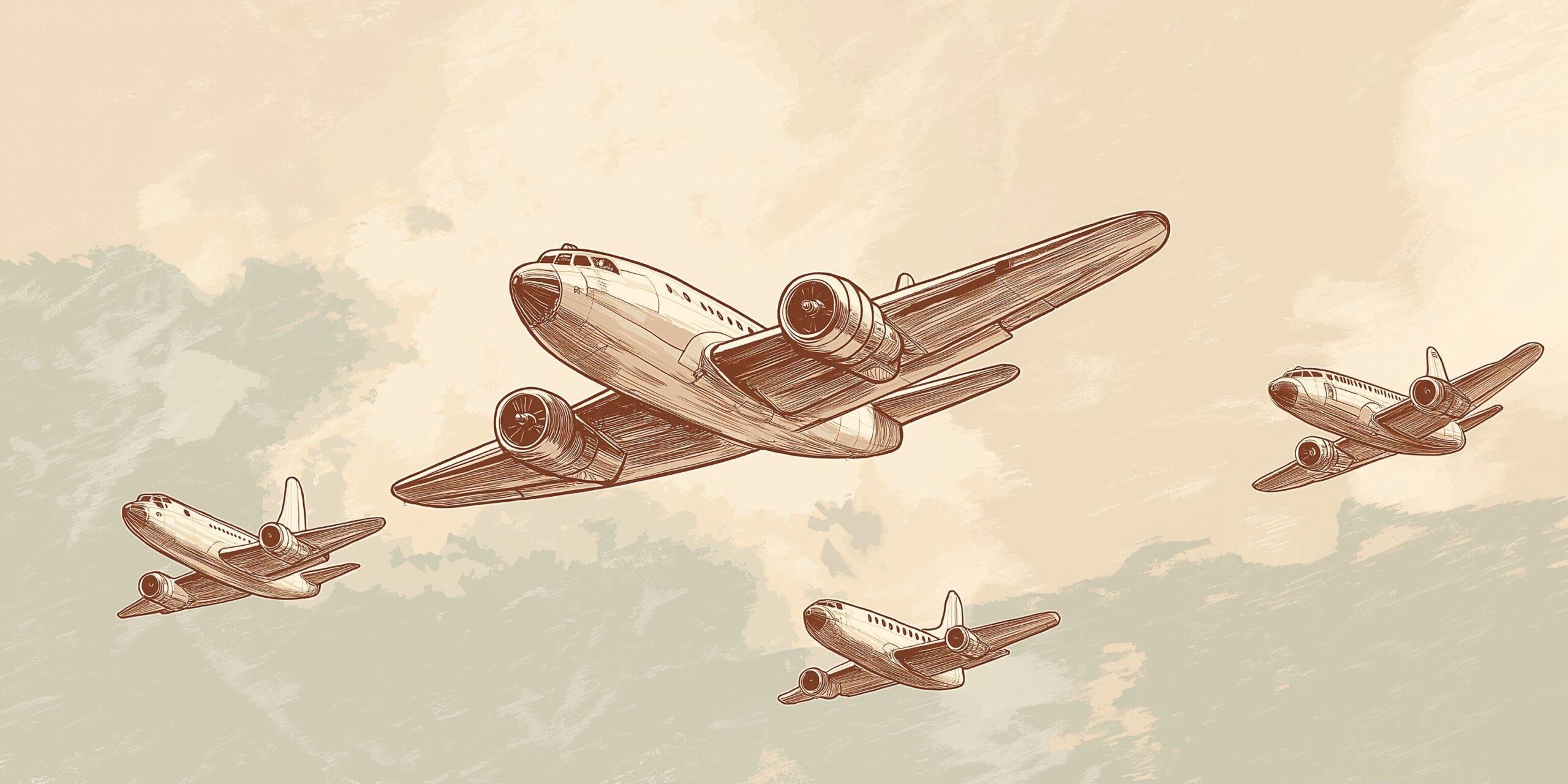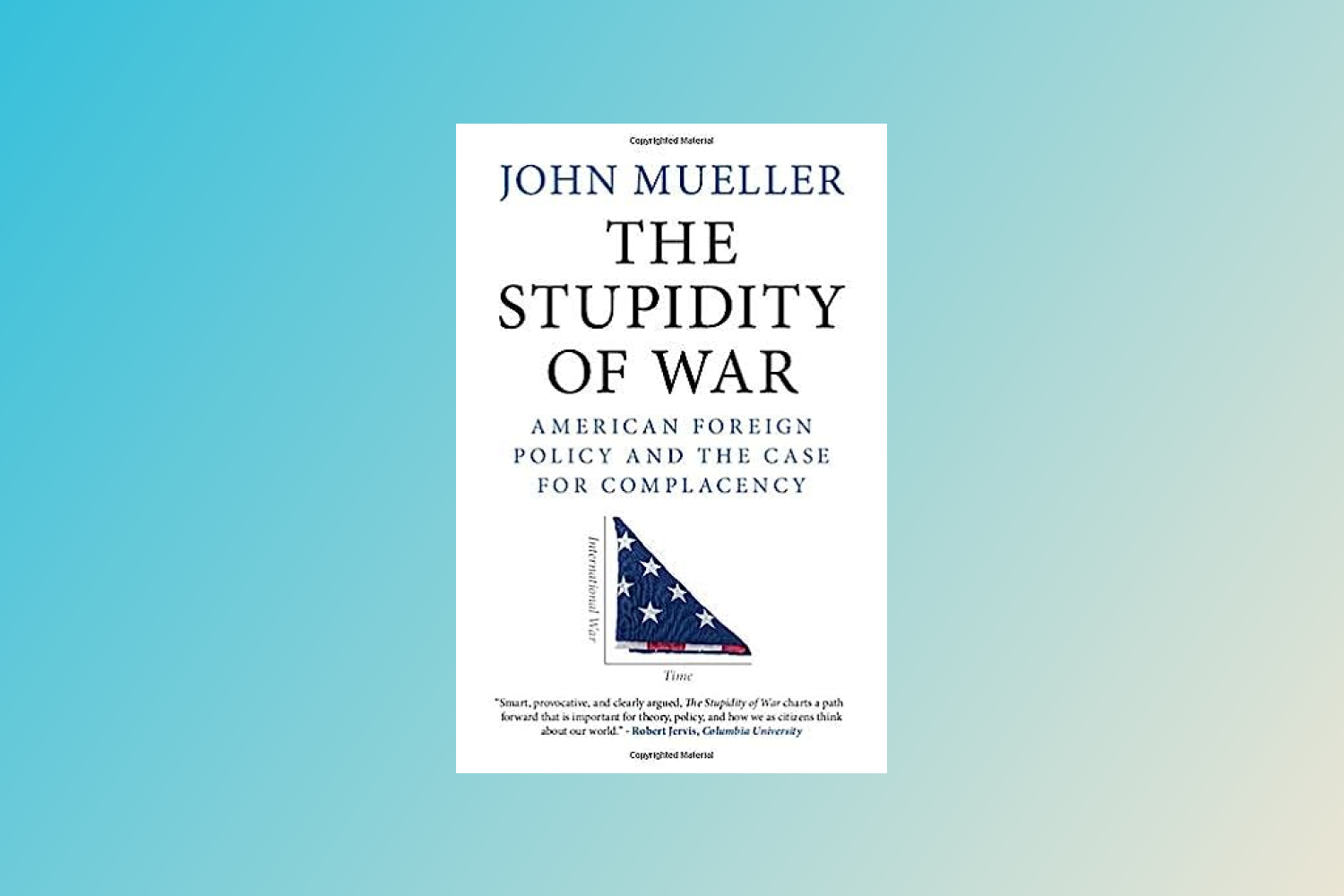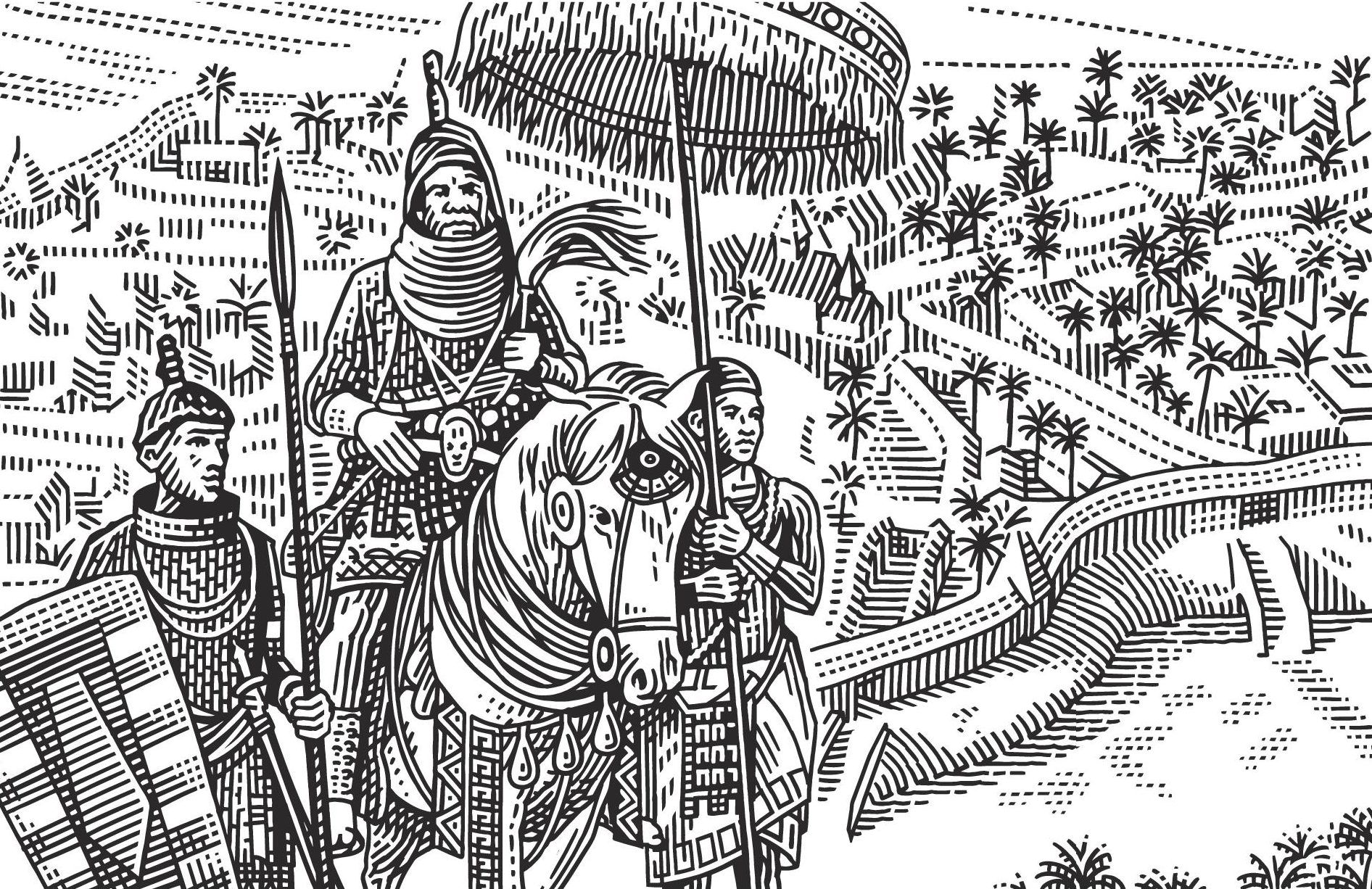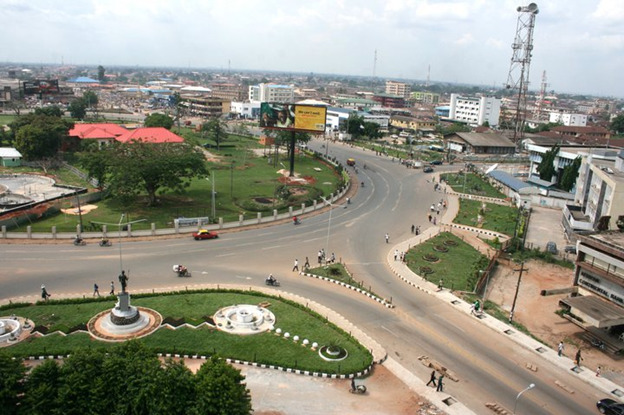Today marks the fourteenth installment in a series of articles by HumanProgress.org called Centers of Progress. Where does progress happen? The story of civilization is in many ways the story of the city. It is the city that has helped to create and define the modern world. This bi-weekly column will give a short overview of urban centers that were the sites of pivotal advances in culture, economics, politics, technology, etc.
Our fourteenth Center of Progress is Benin City, whose walls were once arguably the largest manmade structure on the planet. The wall network of Benin City was collectively four times longer than the Great Wall of China and consumed roughly a hundred times more material to build than the Great Pyramid of Giza in Egypt, according to some estimates. Benin City was the capital of the Benin Empire (1180–1897 AD), which was among the most highly developed states in sub-Saharan Africa before the European colonial period. Benin City was also known for its bronze artworks and a high degree of public order in its heyday. Prosperity requires physical safety from violence and property protection from theft or conquest, and the unprecedented scale of Benin City’s protective walls represented a significant achievement in security.
While the Walls of Benin City eventually fell to a military attack, the record-breaking structure successfully safeguarded the lives and property of those who lived within the city for centuries.
Today, Benin City is the capital and most populous city of Edo State in southern Nigeria, about 200 miles east of the economic and cultural hub of Lagos. Benin City is not to be confused with the country of Benin, which neighbors Nigeria to the west. A major urban center in coastal West Africa, Benin City is home to over 12 million people. Prominent local industries include rubber and oil production. Benin City is known for its festivals, rich dress culture, and for being the site of the royal palace of one of the world’s oldest sustained monarchies—although today, the monarchy is largely ceremonial. The current Oba, or traditional ruler, of the local people, was crowned in 2016 and is considered the 40th Oba of Benin. His palace is a UNESCO World Heritage Site.
The Benin Empire or kingdom, also sometimes called the Edo kingdom, originated sometime around the 10th century AD when the Edo people first settled in the rainforests of West Africa. The empire’s traditional starting year is given as 1180 AD. By the 15th century AD, the Benin Empire was an established regional power. The empire grew wealthier both by conquering neighboring territories and by robust trade with Europeans—initially the Portuguese and later the British. The word “Benin” comes from a mishearing of a word in the West African language Yoruba by Portuguese traders in the 15th or 16th century AD. The story goes that during a royal succession dispute, political pressures led an Oba (king) to renounce his office. As the Oba gave up his title, in frustration, he publicly called the kingdom that he was surrendering the land of “Ibinu,” meaning vexation or anger. In the form “Benin,” the name stuck.
The capital of the Benin Empire was Benin City. If you could visit the city in its golden age, in the 17th century, you would observe a city so orderly that theft was practically unthinkable within its walls. Lourenco Pinto, the Portuguese sea captain of a missionary ship, wrote in 1691 AD, “Great Benin [Benin City], where the king resides, is larger than Lisbon. All the streets run straight and as far as the eye can see. The houses are large, especially that of the king, which is richly decorated and has fine columns. The city is wealthy and industrious. It is so well governed that theft is unknown, and the people live in such security that they have no doors to their houses.”
The city’s security allowed the residents to be highly productive. Pinto also wrote, “The artisans have their places carefully allocated in the squares which are divided up in such a manner that in one square [I] counted altogether one hundred and twenty goldsmith’s workshops, all working continuously.”
Although Pinto wrote “goldsmiths,” what he observed were almost certainly bronze-workers. The city produced thousands of bronze plaques and sculptures created using a technique called low-wax casting. The city’s historic artworks are widely considered to be among the best engravings made using that technique. Some of the bronzes depicted military exploits from the 16th-century period of rapid Benin Empire expansionism. Others represented trade and commerce, diplomacy, and dynastic history. However, most of the artworks were simply portraits of Benin’s nobility garbed in elaborate ceremonial clothing.
Benin City’s people also produced a great amount of cloth, which played a significant role in trade with European merchants. Other locally produced trade goods included pepper, palm oil, carved ivory, and beads made from cowrie shells and other materials. Benin City’s people also sold slaves—often neighboring Africans captured in battle—to the Europeans. Because, distressingly, like almost all ancient societies, the Benin kingdom practiced slavery.
Despite its security achievements defending against outside threats, a modern person would not wish to live in ancient Benin City. Benin City’s people practiced ritual human sacrifice with various rationales, including honoring a god of iron and petitioning the gods for profitable trade. The victims were often prisoners with criminal backgrounds. By the end of the 18th century CE, three or four human sacrifices occurred at Benin City’s river’s mouth annually, ostensibly to ensure good trade with European merchants.
Among the city’s most important imports were brass and copper ingots from the Europeans. The Benin Empire did not produce enough metal locally to supply Benin City’s prolific engraving and sculpture industries fully. Many of the city’s famed bronze artworks would not have been possible without the benefits of overseas trade. The Portuguese often sold bronze and copper to Benin City’s people in the form of metal bracelets called “manillas.” By the 16th century AD, manillas and other metal objects (such as bronze pots and pans) were a standard trade currency used by Europeans in West Africa.
As trading grew more sophisticated, early factories or centers for the production of local goods like cloth sprung up along the main Benin City river. Always mindful of security, the Benin kingdom entered into various alliances to prevent piracy of trade goods.
Given the importance of trade to Benin City’s success, it is fitting that one of the city’s most beloved historical figures was a market woman. Her statue now graces a prominent place in Benin City. Emotan was a 15th-century merchant who, according to oral tradition, sold her wares at the point where her statue now stands. She founded the first childcare center in Benin City, opening up a nursery for the children of families patronizing Benin City’s marketplace. She once warned a prince of Benin of a plot against his life and helped him regain the throne from his brother. The new king then rewarded her by appointing her to a high position charged with enforcing security in the marketplace. Emotan is now locally revered and deified as the “conscience of justice.”
The city’s wealth grew thanks to its thriving markets and international trade, as well as due to the Benin kingdom’s successful imperialism. As the city became richer, that wealth improved its infrastructure and many of its people’s lives. “Houses are built alongside the streets in good order, the one close to the other,” noted the 17th-century Dutch writer Olfert Dapper. “Adorned with gables and steps and roofs made of palm or banana leaves, or leaves from other trees … they are … usually broad with long galleries inside, especially so in the case of the houses of the nobility, and divided into many rooms which are separated by walls made of red clay, very well erected.”
Dapper also noted that residents kept those walls “as shiny and smooth by washing and rubbing as any wall in Holland can be made with chalk, and they are like mirrors. The upper storeys are made of the same sort of clay. Moreover, every house is provided with a well for the supply of fresh water.”
Benin City was also notably among the first urban centers to have a likeness of street lighting. There were large metal lamps that burned palm oil, standing many feet high, placed around the city.
The king’s court was square and stood at the right side as one entered the city by its main gate. A wall like the one that encircled the city surrounded the court. The court housed various palaces, houses, and apartments for courtiers and boasted beautiful long and square galleries. Those galleries were “about as large as the Exchange at Amsterdam,” according to Dapper. The largest gallery hosted many of the city’s famed bronze carvings. Scenes engraved into bronze plaques stood supported by wooden pillars throughout the gallery.
However, Benin City’s wall network would have been the city’s most impressive sight. Radiocarbon dating of the walls’ remains suggests that the Edo people built up Benin City’s walls gradually over many years. Most of the construction likely occurred between 800 and 1500 AD.
“[T]he Benin [wall] network,” English author and journalist Fred Pearce wrote, “extend[s] for some 16,000 kilometres in all, in a mosaic of more than 500 interconnected settlement boundaries. They cover 6500 square kilometres and were all dug by the Edo people. In all, they are four times longer than the Great Wall of China, and consumed a hundred times more material than the Great Pyramid of Cheops. They took an estimated 150 million hours of digging to construct, and are perhaps the largest single archaeological phenomenon on the planet.”
The walls extended, in other words, for around 10,000 miles and covered some 2,500 square miles. That number of square miles is comparable to the Los Angeles-Riverside urban area in California today. Since Peace wrote those words, the official length of China’s Great Wall, defined to include various distinct border walls built in all dynasties of Chinese history, has been updated to around 13,000 miles. However, that figure, calculated by China’s State Administration of Cultural Heritage, has been called “misleading.” It includes many isolated, disconnected walls defending various state boundaries within China, not just China’s famed northern border wall. Estimates of the northern border wall’s length vary from 1,500 to 5,000 miles, depending on exactly which wall sections are counted. In any case, Benin City’s walls were certainly longer than China’s storied northern border wall.
In places, the towers of Benin City’s walls reached seven stories high. The walls also boasted guardhouses, ditches, moats, and garrison barracks. After guarding the city for centuries, the Walls of Benin fell to British troops in 1897 during a “punitive expedition” motivated by British revenge for an earlier military strike by the Benin Empire. However, trade disputes also motivated the attack. Many of the royal palace’s bronze artworks were captured in battle and are today displayed in the British Museum and various other museums.
After its walls fell, Benin City—and the Benin Empire—became part of the British Empire. Benin City then became part of Nigeria in 1960.
Safeguards against those who would steal or plunder have often proven indispensable in ensuring property rights. While the walls of Benin City eventually fell, for centuries, the record-breaking security feature protected the city. Human beings have created walls and other protective structures since they first switched from nomadism to permanent agricultural settlements. Many of the world’s oldest stationary communities took the form of walled cities—such as our inaugural Center of Progress, Neolithic-era Jericho. However, the Walls of Benin City surpassed all others in sheer scope. For the significant achievement in security of its record-shattering walls that stood for hundreds of years, Benin City is our fourteenth Center of Progress.




